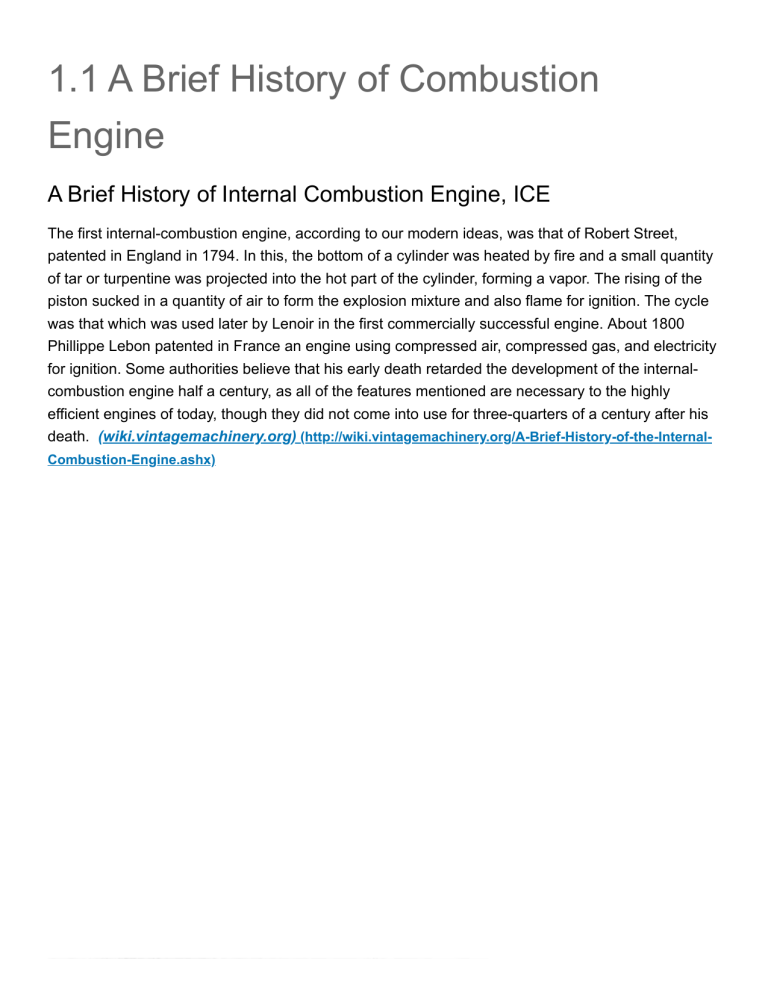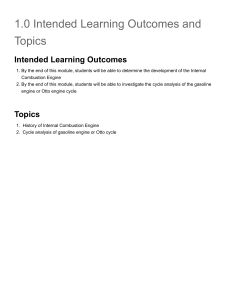
1.1 A Brief History of Combustion Engine A Brief History of Internal Combustion Engine, ICE The first internal-combustion engine, according to our modern ideas, was that of Robert Street, patented in England in 1794. In this, the bottom of a cylinder was heated by fire and a small quantity of tar or turpentine was projected into the hot part of the cylinder, forming a vapor. The rising of the piston sucked in a quantity of air to form the explosion mixture and also flame for ignition. The cycle was that which was used later by Lenoir in the first commercially successful engine. About 1800 Phillippe Lebon patented in France an engine using compressed air, compressed gas, and electricity for ignition. Some authorities believe that his early death retarded the development of the internalcombustion engine half a century, as all of the features mentioned are necessary to the highly efficient engines of today, though they did not come into use for three-quarters of a century after his death. (wiki.vintagemachinery.org) (http://wiki.vintagemachinery.org/A-Brief-History-of-the-InternalCombustion-Engine.ashx) Figure 1.1 Brown Gas Vacuum Engine The next engine to attain any considerable prominence was that of Samuel Brown, who secured several patents in England about 1825. His engine did not represent an advance, since the old ideas of Huygens were employed instead of the advanced ideas of Street. The success of the atmospheric steam engines was probably responsible for this. Brown's engine consisted of a number of large chambers, in which the hot gases produced by flame were cooled by the injection of water, thus forming a partial vacuum. The working pistons, in cylinders adjacent to the large chambers, were operated by atmospheric pressure, all pistons being connected to the same crankshaft. Since the burning did not occur in the working cylinder, the engine can scarcely be called an internalcombustion engine in the accepted sense of the term. The inventor appears to have been a man of considerable force, and a number of his engines were built for pumping and for driving carriages and boats. In 1833, W. L. Wright patented in England.. The gas and air were supplied by separate pumps to a working cylinder. The charge was contained in the spherical bulbs near the ends of the cylinder, ignition occurring while the piston was at the end of the stroke. The engine was double acting, waterjacketed, with poppet exhaust valves and a fly-ball governor. It represented a great advance in design and was probably built, though no records of its performance are known to exist. (wiki.vintagemachinery.org) (http://wiki.vintagemachinery.org/A-Brief-History-of-the-InternalCombustion-Engine.ashx) Figure 2. Wright's Internal Combustion Engine The well-known Otto engine was invented by Dr. Nicholas Otto, of Germany, and was patented in this country in 1877. It follows the cycle that has been described by Beau de Rochas, now known as the four-cycle, or sometimes as the Otto cycle. The engine was first known as the Otto-Silent, to distinguish it from the free-piston engine, which was rather noisy. It immediately established the internal-combustion engine on a firm footing, and the engines of the four-cycle type sold today show merely minor improvements. The sliding valve in 1876 has been replaced by poppet valves, and the flame ignition has been replaced by the electric spark. Otherwise, the Otto cycle of 1876 has persisted and at this time thousands of them are being manufactured. Figure 3. Early Otto Engine The development of the Diesel engine for oil began about 1894. As has been stated, this engine is similar to the Brayton. Air is compressed to about 500 pounds pressure and oil is sprayed into this highly compressed air. It burns spontaneously at nearly constant pressure, which is followed by a long expansion. The extremely high temperature of the air previous to the injection of the fuel and the high temperature maintained during this injection, together with the long expansion, give the engine the highest efficiency of any thermal motor. The development of the Diesel engine has been so recent that it is not necessary to elaborate upon it. At this time, it is being manufactured in all of the European countries and in America, and there is a tendency on the part of many of the American manufacturers who are bringing out new engines to adopt the features of the Diesel. The gas turbine is as yet in the experimental stage. A number have been built and are of course, extremely interesting. The success of the steam turbine has encouraged many to believe that the gas turbine will achieve similar success. Nothing of recent development can be said to encourage this view. The difficulties in the way of successful gas turbines are very great, and while some turbines have been designed and run, none of them has shown an efficiency at all comparable to that of ordinary fourcycle engines.



